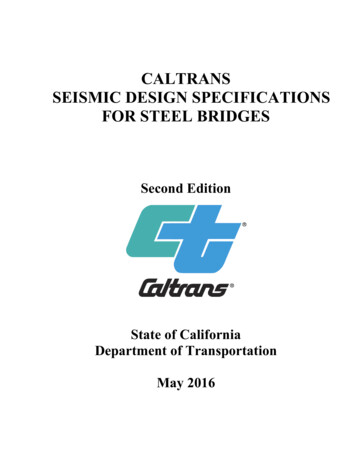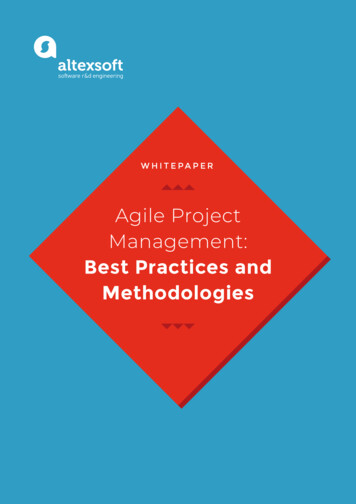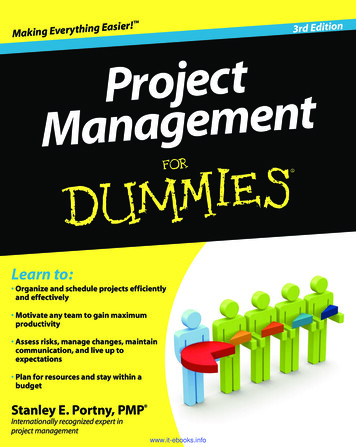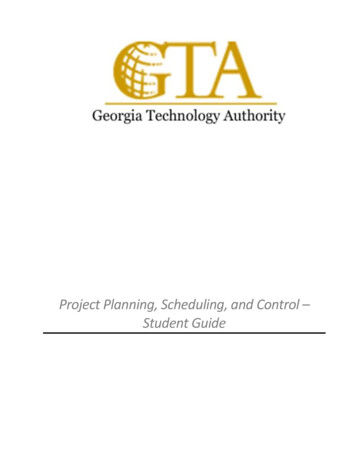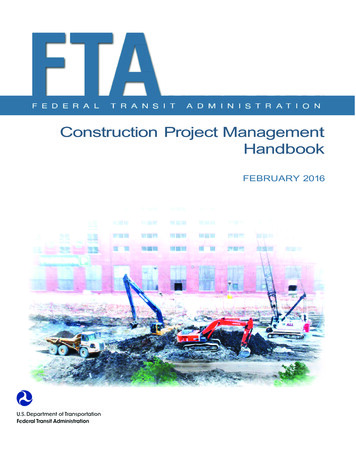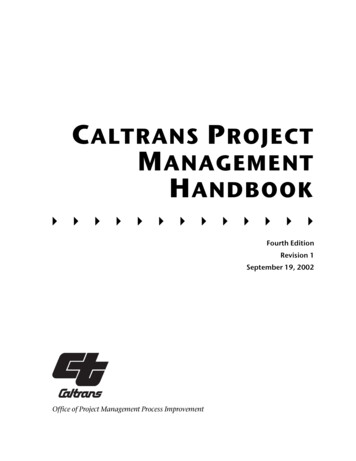
Transcription
C ALTRANS P ROJECTM ANAGEMENTH ANDBOOKFourth EditionRevision 1September 19, 2002Office of Project Management Process Improvement
Caltrans Office of Project Management Process Improvement1120 N Street, Mail Station 28Sacramento, CA 95814www.dot.ca.gov/hq/projmgmtCaltrans Project Management HandbookSeptember 19, 2002Rev 1
PrefaceThe Caltrans Project Management Handbook provides an updated overviewof project management at Caltrans.This version is effective as of October 1, 2002.The project team thanks all individuals within the districts andheadquarters for their support and contributions to the production of thishandbook.PurposeThis document provides an overview of the basic concepts that guideproject management at Caltrans.AudienceCaltrans project managers and other staff acting in a project managementcapacity.BackgroundThis edition is a reorganization, clarification, and completion of theinformation in the Third Edition dated April 1999. Only a small amount ofpolicy/subject matter has changed. The goal of this edition is to make thepresent policy/subject matter more useful and easier to understand.This document supersedes all previous editions of the Caltrans ProjectManagement Handbook and the Project Management Terms and Definitionscontained in any Project Management Directive published before May 13,2002.RevisionsRevision 1 represents the original version of the 4th edition.ConventionsTitles of books appear in italics.Web site URLs appear in bold italics.Caltrans Project Management Handbookiii
CCONTENTSPreface .iiiPurpose.iiiAudience .iiiBackground.iiiRevisions .iiiConventions.iiiFigures . viiiBasic Concepts .9What Is a Project? . 10What Is Project Management? . 11Why Do We Do It?. 11Project Management Mission . 11Program Management . 12Portfolio Management . 13The Big Picture . 14Project Lifecycle .17Lifecycle Overview. 18Project Initiation Document Component . 19Caltrans Project Management Handbookv
ContentsPID Deliverables.19Permits and Environmental Studies Component .20Permits and Environmental Studies Deliverables .20Plans, Specifications, and Estimate Component.21PS&E Deliverable .21Right of Way Component.22Right of Way Deliverables .22Construction Component .23Construction Deliverables .23Project Processes . 25Processes Overview.26Process Groups .27Initiating Processes .28Planning Processes.28Executing Processes .29Controlling Processes .31Closing Processes .31Knowledge Areas .32Project Integration Management .32Project Scope Management .33Project Time Management .33Project Cost Management.33Project Quality Management .33Project Human Resource Management .34Project Communications Management .34Project Risk Management.34Project Procurement Management .35People . 37Roles .38Stakeholders .38Project Team.39Project Development Team.40Responsibilities.41Concepts .41Responsibility Matrix.42Functional Deputy District Directors and Deputy Division Chiefs in the Division ofEngineering Services .46Project Management Support Unit .46Consultant Services Unit .46One-Hat and Two-Hat Project Managers .47viCaltrans Project Management Handbook
ContentsOne-Hat Project Managers . 47Two-Hat Project Managers . 48Tools.49Project Management Plan. 50Project Charter . 51Workplan . 52Work Breakdown Structure . 52Resource Breakdown Structure. 52Organizational Breakdown Structure. 52Information Systems. 53California Transportation Improvement Program System (CTIPS) . 53Project Resource and Schedule Management (PRSM) . 53Transportation Accounting and Management System (TRAMS). 53Systems Being Replaced . 53Glossary .55Acronyms.59Index .61Caltrans Project Management Handbookvii
ContentsFiguresFigure 1. Knowledge and skill sets needed for effective state highway project management.14Figure 2. Components in the project lifecycle.18Figure 3. Process group interaction .27Figure 4. Organizational structure: one-hat project manager.47Figure 5. Organizational structure: two-hat project manager .48viiiCaltrans Project Management Handbook
1BASIC CONCEPTSThis chapter:Defines what “project,” “project management,” “programmanagement,” and “portfolio management” mean at CaltransExplains the purpose and goals of project management at CaltransProvides a “big picture” view of project management as one of thefive knowledge and skill sets needed for project successCaltrans Project Management Handbook9
What Is a Project?Basic ConceptsWhat Is a Project?A Guide to the Project Management Body of Knowledge (PMBOK Guide)1defines a project as “ a temporary endeavor undertaken to produce aunique outcome.” A Caltrans capital project produces a unique physicalimprovement to the transportation system in California. “Project” refers tothe work that is performed. Projects produce products. A project istemporary because it has a definite beginning and a definite end. Theoutcome is unique because it differs in some distinguishing way from allsimilar products or services. For example, Caltrans may be engaged inmany highway maintenance projects, but each project is unique because itinvolves a unique location and work elements on a specific section ofhighway.Caltrans divides each project into “components,” each of which produces amajor product required by law. Collectively, these components constitutethe “project lifecycle.” For more information on the Caltrans projectlifecycle, see “Project Lifecycle” on page 17.Caltrans capital projects receive funding from programs such as the StateTransportation Improvement Program (STIP), the State Highway Operationand Protection Program (SHOPP), etc. See “Program Management” on page12 for more information.1 Project Management Institute, 200010Caltrans Project Management Handbook
Basic ConceptsWhat Is Project Management?What Is Project Management?The PMBOK Guide defines project management as “ the application ofknowledge, skills, tools, and techniques to project activities in order tomeet or exceed sponsors’ needs and expectations from a project.” Projectmanagement balances competing demands (scope, time, cost, quality,requirements, etc.) throughout the project lifecycle and involves theinteraction of three elements:People — People perform the work and determine the success orfailure of a project. “People” on page 37, discusses the organizationalstructure and responsibilities of the project team and otherstakeholders involved in Caltrans project management.Processes — Processes specify products or deliverables required forthe project and identify who will perform the work and when.“Project Processes” on page 25 discusses project managementprocesses used at Caltrans.Tools — People use predefined tools and techniques to manage theproject. “Tools” on page 49 discusses project management tools usedat Caltrans.Why Do We Do It?Limited available resources (compared to transportation needs) require theefficient use of tax dollars. Project management helps Caltrans maintainefficiency by making sure that the right people complete the right tasks atthe right time.ProjectManagementMissionCaltrans delivers transportation improvements that meet customer needs.Caltrans project teams use project management standards to deliverquality projects that are timely and cost-effective. The purpose of projectmanagement is to:Deliver projects that satisfy customer needsImprove project delivery performance related to quality, scope,schedule, and costReduce the support cost of producing the projectDo the right things right the first timeAnticipate and respond to issues before they become problemsCommunicate effectively with stakeholdersManage changeManage riskCaltrans Project Management Handbook11
What Is Project Management?ProgramManagementBasic ConceptsThe PMBOK Guide defines a program as “ a group of related projectsmanaged in a coordinated way to obtain benefits not available frommanaging them individually.” Laws and regulations establish programs forgovernment projects. These laws and regulations define each program’spurpose, funding sources, and funding process. In California Stategovernment, resources for programs must be approved by the legislature inthe annual budget.For 2002-03, 11 programs fund state highway improvement projects:ProgramAuthoritySTIP Interregional ImprovementProgram (IIP)Government code 14529 (a) (1)STIP Regional Improvement Program(RIP)Government code 14529 (a) (2)SHOPPGovernment code 14526.5Phase 2 and Toll Bridge Seismic RetrofitPhase 2 retrofit: Government code 8879Toll Bridge retrofit: Streets & Highwayscode 188.5Toll Bridge ProgramStreets & Highways code 30950Transportation Enhancement Activities(TEA) – Caltrans ShareCalifornia Transportation Commission(CTC) Resolution 00-18 (This is a federalprogram with matching funds from theSHOPP)Special Retrofit SoundwallsItems 2660-302-0042 and 2660-3020890 of the 2000 Budget Act (Chapter52, Statutes of 2000)“Grandfathered” Traffic SystemsManagement (TSM) – programmed in1997 or earlierStreets & Highways code 164.1(repealed in 1997 – no projects can beadded to this program)Safe Routes to SchoolStreets & Highways code 2333.5Traffic Congestion Relief Program(TCRP)Government Code 14556State Highway Projects Funded fromOther SourcesAnnual State BudgetFunds for every state highway project come from one or more of theseprograms. Project managers must know which programs are funding theirprojects, and understand the particular funding rules of those programs.The “State Highway Projects Funded from Other Sources” program coversany project funded from sources other than the first 10 programs. Caltransperforms limited work on these projects. The Legislature provides anannual budget for this work.12Caltrans Project Management Handbook
Basic ConceptsWhat Is Project Management?Sub-ProgramsPrograms may have sub-programs. For instance, SHOPP includes the MinorProgram and Roadway Rehabilitation Program sub-programs. Each subprogram has a particular funding process that sets it apart from the rest ofits parent program.Project Management vs. Program ManagementThis handbook describes the management of a single project; it does notcover program management. The following table summarizes thedifferences.PortfolioManagementProject ManagementProgram ManagementThe direction and supervision of oneprojectThe integration, coordination,communication, and simultaneouscontrol of multiple projectsA disciplineAn operating environmentProject-wide (a tactical issue)Enterprise-wide (a strategic issue)“Portfolio management” is the management of the projects or portions ofprojects assigned to a particular individual or unit.Portfolios exist at every level of the organization:An individualA sectionA branchAn officeA districtAll of CaltransPortfolios often include projects or portions of projects funded from severaldifferent programs.The portfolio concept is borrowed from the stock market. In this analogy,each company equates to a project, and each share equates to a task withinthe project. Just as each investor owns a different stock portfoliocontaining shares in various companies, each individual and unit has adifferent portfolio containing tasks on various projects.This handbook describes the management of a single project; it does notcover program management or portfolio management.Caltrans Project Management Handbook13
The Big PictureBasic ConceptsThe Big PictureFigure 1. Knowledge and skill sets needed for effective state highway project managementFor projects to be successful, the project team must understand and applygenerally accepted project management techniques such as workbreakdown structures, critical path analysis, and earned value. While theyare necessary, these techniques alone are not sufficient for effective projectmanagement. Effective management of California state highway projectsrequires that the project team understand and use five knowledge and skillsets:Project management knowledge and practices — these consist ofproject lifecycle definition, five project management process groups,and nine project management knowledge areas. All of these aredescribed in the remainder of this handbook.State highway project standards and procedures — the ProjectDevelopment Procedures Manual is the primary source of theseprocedures. More detailed information on the standards andprocedures is contained in manuals, guides, handbooks, andbulletins issued by the Federal Highway Administration (FHWA), theAmerican Association of State Highway and Transportation Officials(AASHTO), and Caltrans Headquarters Divisions. In some instances,districts may have procedures to address their unique situations(such as a district hydraulics manual that addresses the particularhydrology in that geographic area). Many procedures are standard toan employee’s profession and are documented in academictextbooks and professional journals.14Caltrans Project Management Handbook
Basic ConceptsThe Big PictureUnderstanding of the project context — the project team mustunderstand the project in its social, biological, and physicalenvironment. The team must understand how the project affectspeople and how people affect the project. This may require anunderstanding of aspects of the political, economic, demographic,educational, ethical, ethnic, religious, and other characteristics ofthe people who will be affected by the project or who have aninterest in the project. Some team members must be familiar withapplicable federal, state, and local laws and with the relevantportions of the budgets of the entities that are funding the project.Other team members must be knowledgeable about the flora, fauna,geology, and physical geography of the region around the project.General management knowledge and practices — these are neededfor the management of any enterprise. They include strategicplanning, health and safety practices, marketing and sales, financialmanagement and accounting, and personnel administration.Human relations skills — these are often called “soft skills,”including the management of relationships with others and themanagement of oneself. Soft skills include communication,teamwork, leadership, conflict management, negotiation, problemsolving, motivation, delegation, personal time management, andstress management. Every person can improve his/her soft skillsthrough training and practice.It is not necessary for every team member to possess all these knowledgeand skill sets. In fact, it is unlikely that any one person will have all ofthe knowledge and skill necessary for project success. Some aspects ofthese knowledge and skill sets might not be needed on a particularproject, but they should be available “on call” within Caltrans orthrough consultants.Caltrans Project Management Handbook15
2PROJECTLIFECYCLEThis chapter describes each component in the project lifecycle.Caltrans Project Management Handbook17
Lifecycle OverviewProject LifecycleLifecycle OverviewCaltrans divides each project into project components, each with its ownoutcomes, or “deliverables.” The Caltrans Project Delivery WorkBreakdown Structure (WBS), described on page 52, defines the deliverablesfor each component.Together, the project components make up the project lifecycle.Figure 2. Components in the project lifecycle18Caltrans Project Management Handbook
Project LifecycleProject Initiation Document ComponentProject Initiation Document ComponentCaltrans capital projects start with a problem that needs to be solved.Before a project starts, the Planning Division generates a list of potentialprojects, each with a “purpose and need” statement. Any work on theproject, throughout the project’s lifecycle, must relate back to the originalpurpose and need statement.PID DeliverablesThe main deliverables for the Project Initiation Document (PID)component are:The PID — contains a defined project scope, a reliable capital andsupport cost estimate for each alternative solution, and a projectworkplan for the alternative recommended for programming theproject.The Stakeholders List — is a communication tool that becomes partof the Project Communication Plan. Appendices A and B of theCaltrans Project Communication Handbook explain the ProjectStakeholders List and Analysis.Caltrans Project Management Handbook19
Permits and Environmental Studies ComponentProject LifecyclePermits and Environmental Studies ComponentFor a capital project to proceed, it must receive official federal, state, andenvironmental approvals as well as approval from all the stakeholders andthe public. By the end of this component, the stakeholders should agree ona preferred alternative that has a reasonably mitigatable impact on theenvironment.Permits andEnvironmentalStudiesDeliverablesThe main deliverables for the Permits and Environmental Studiescomponent are:The Final Project Report — further refines the purpose and need,identifies the alternative selected, describes how that alternative wasdecided upon, and describes how consensus was reached betweenCaltrans and stakeholders. It also includes more detailed engineeringdesigns required under the California Environmental Quality Act(CEQA) and the National Environmental Policy Act (NEPA).The Final Environmental Document — contains requiredenvironmental approvals. For more information, see the CaltransStandard Environmental Reference.20Caltrans Project Management Handbook
Project LifecyclePlans, Specifications, and Estimate ComponentPlans, Specifications, and Estimate ComponentConstruction companies must know what a project requires in order to bidfor the contract. The plans, specifications, and estimate created in thiscomponent provide companies with the information they need to developan accurate bid.PS&E DeliverableThe Plans, Specifications, and Estimate (PS&E) package — includes thedetailed designs/plans for the project, detailed project specifications(material to use, contract guidelines, permits needed, etc.), and estimatesfor the exact amounts of materials needed and their costs. This packageincludes only capital costs (costs for materials), not support costs. ThePS&E forms the basis for the contract bidding process.When the PS&E package is complete, the project should be biddable andbuildable. That is, contractors have enough information to bid accurately,and they can build what they bid to do.Caltrans Project Management Handbook21
Right of Way ComponentProject LifecycleRight of Way ComponentCaltrans is required to obtain property rights for the construction of manyof its transportation projects. The Right of Way component involvespreparing maps and legal documents, preparing appraisals, obtaining legaland physical possession of property, relocating occupants, and clearing allphysical obstructions, including utilities. Other required activities includemanaging properties, selling excess properties, monumentation of theright of way, relinquishments and vacations, and preparing right of wayrecord maps.Right of WayDeliverablesThe main deliverables for the Right of Way component are:The Right of Way Certification —summarizes the status of all right ofway matters pertaining to a proposed construction project. TheRight of Way Certification is included in the PS&E package.Legal right of way — secures all real property rights that are requiredfor the project, and relocates occupants according to federal andstate laws, regulations, and procedures.Clearance of physical obstructions from the right of way — removesimprovements, relocates utilities, and executes all railroadagreements.22Caltrans Project Management Handbook
Project LifecycleConstruction ComponentConstruction ComponentAfter the construction contract for a Caltrans capital project has beenawarded, construction can begin.ConstructionDeliverablesThe main deliverables for the Construction component are:The constructed physical improvement — follows the guidelines inthe current edition of the Construction Manual.The Final Estimate — includes the final quantity and cost of the workfor which the contractor has been paid.The As-Built Plans —reflects what was actually built, including anyplan changes made during construction.The Project History File — follows the guidelines in Section 3 ofChapter 15 of the Project Development Procedures Manual.Caltrans Project Management Handbook23
3PROJECTPROCESSESThis chapter explains how the PMBOK Guide process groups andknowledge areas apply to project management at Caltrans.Caltrans Project Management Handbook25
Processes OverviewProject ProcessesProcesses OverviewEach component involves a series of processes from five “process groups.”The PMBOK Guide defines a process as “a series of actions bringing about aresult.” Project processes fall into one of two categories:Project management processes — describe and organize the work of aproject. For example, during the PID component (page 18), theproject manager distributes information to and from stakeholders,defines the scope of the project, and facilitates decision-making.Product-oriented processes — specify and create the product. Theseprocesses are summarized in the “executing processes” section of thischapter (on page 29). More detailed descriptions are provided in theGuide to the WBS and in the manuals, guides, and handbooks that arereferenced in the Guide to the WBS.26Caltrans Project Management Handbook
Project ProcessesProcess GroupsProcess GroupsCaltrans divides project management activities into five generally acceptedprocess groups, matching those in the PMBOK Guide:Initiating Processes (page 28)Planning Processes (page 28)Executing Processes (page 29)Controlling Processes (page 31)Closing Processes (page tureExpenditureAuthorizationAuthorizationWBS 100PlanningPlanningDraftDraftWorkplanWorkplanWBS terative erStakeholderAnalysisAnalysisApproved Change (New BS ngStatusStatusInformationInformationDistrib
Management Handbook and the Project Management Terms and Definitions contained in any Project Management Directive published before May 13, 2002. Revisions Revision 1 represents the original version of the 4 th edition. Conventions Titles of books
